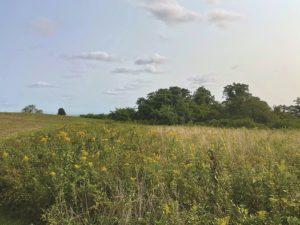September, the golden month on Cape Cod. Sunrises and sunsets that linger in the mind’s eye with color and light. Solidago sempervirens, seaside goldenrod, is just beginning to open at Eastham’s First Encounter Beach. A walk at Fort Hill reveals multiple species in flower, like yellow fireworks that fell from the sky.
There are 11 species of Solidago on Cape Cod, all bursting with bright golden flowers throughout late summer into fall, save one: silverrod, that is, Solidago bicolor. Its tiny flowers are white, crowded on long stalks with deep green leaves that travel up the entire length of the stem. But, for the most part, members of this species are hard to discern from one another; leaves, scent, and habitat can be clues.

Goldenrod is often confused with ragweed, a similar-looking plant that releases airborne pollen. Solidago’s pollen is sticky and heavy. Bees, wasps, and butterflies visit often, collecting nectar from the plant’s many flowers. Goldenrod’s late blooming season offers fodder for beneficial pollinators before winter hibernation.
This herbaceous perennial thrives in a variety of habitats across our landscape — on dunes and meadows, roadsides and gardens. But you’ll see its flowers only once the days turn shorter and nights get longer. Also called photoperiodism, this response from both plants and animals is due to the amount of night sky they’re exposed to. Solidago’s reign over the landscape this time of year is a sign of fall to come, summer made whole.
Nights lengthen. The sun begins to dip lower in the sky. As the month moves closer to the equinox, yellow flowers fade to a dull ochre fire, seeds carried off by the wind. Rhizomes have spread underground. Next spring, these newcomers will grow inconspicuously throughout the landscape until the longer nights arrive, once again calling forth a riot of golden flowers.
In Latin, solidago means “to make whole,” and the plant was used to treat multiple ailments in traditional medicine. Indigenous Americans used it as a remedy for toothache, fever, and cough, besides using it as a dye to create shades of yellow. Natural dyers still work with this plant today.
Its anti-inflammatory qualities make goldenrod an important ingredient in a soothing salve for sore muscles. This one is made by first infusing a skin-nourishing oil with the flowers.
Goldenrod Salve

The infused oil is simple to do but will take a few weeks to be ready. Then you’ll melt beeswax, mixing it into the infused oil to make the salve. One part beeswax to four parts oil is the traditional ratio; increase the oil for a softer texture. It’s good to have a heatproof glass measuring cup reserved for the melting and mixing.
Goldenrod tips and flowers
About 2 cups oil
4 oz. beeswax
A quart mason jar
Cheesecloth
A large glass measuring cup
Tins or jars for the salve
Harvest a large basket full of plant tips and flowers, and let them dry in a well ventilated place until crunchy. Chop into small pieces and pack them into a sterile quart-size mason jar.
Cover the flowers with jojoba oil or any heat-safe, skin-nourishing oil (almond or olive are also good). Cap with the lid and place the jar in a sunny spot for a few weeks, shaking daily.
Strain the oil through cheesecloth to remove the flowers and plant material. Add one part beeswax and four parts infused oil to a heatproof glass measuring cup. Place cup in a pot with water, creating a double boiler. Melt wax and oil over very low heat. Carefully pour into sterile jars or tins and allow to cool before capping.
